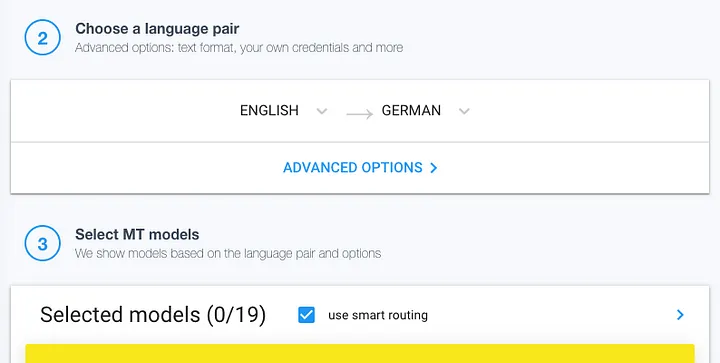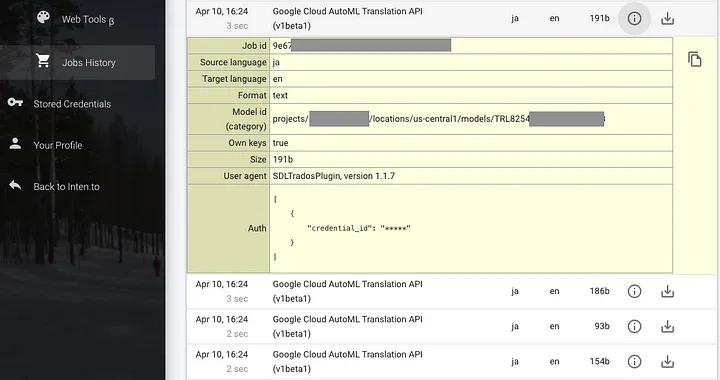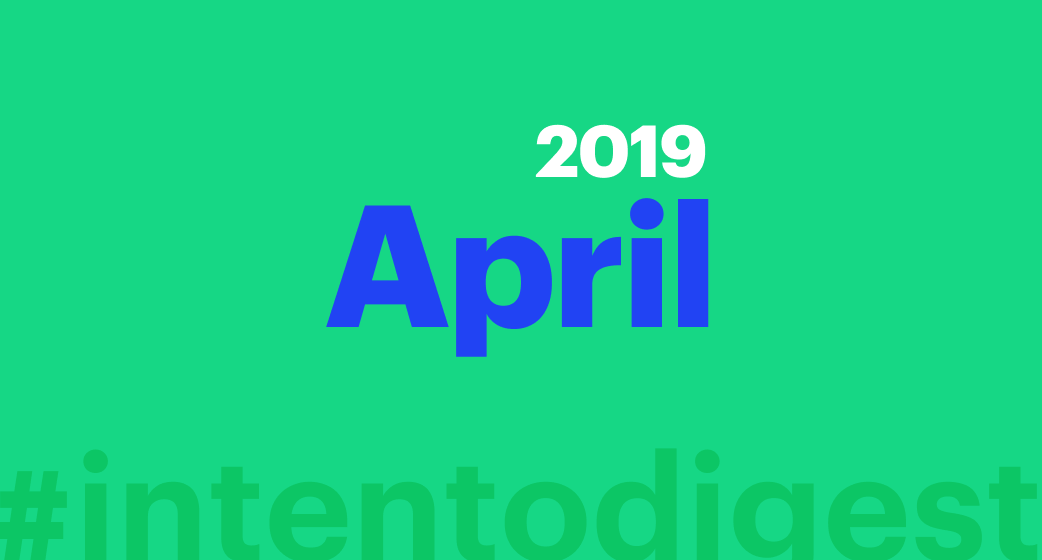1. Intento Smart Routing
We do not just publish nice MT Evaluation Reports, we use them to select the right stock MT engine for every language pair, in real time.
This mode, dubbed “Smart Routing”, was previously available only for users of our synchronous API. Last week, we rolled it out to our main asynchronous API, our SDL Trados and memoQ plugins, and Intento Web Tools.

Intento Smart Routing in Web Tools.
In this mode, we route your requests to one of the 9 top-performing MT systems from the most recent evaluation report (January 2019, to be updated soon), with several important differences:
- The requests are routed only to affordable systems (<$25 per 1M characters). If you are ready to pay more than $400 for 1M characters, we need your explicit consent.
- We route only to systems with full data protection and confidentiality. If you want to let someone use your data to improve their models, please do that consciously.
- We route only to stable and reliable commercial systems.
- In some cases, we identified that ranking on private data differs from the ranking for public WMT dataset in the report. We use those insights.
- For language pairs that are not in the report, we extrapolate.
And one more thing about the Smart Routing! If you need a custom routing schema because the MT engine ranking is different for your domain or because you want to route requests to your custom NMT engines — let us know and we’ll help to set it up.
2. Intento Sentence Aligner
In the Machine Translation solutions we implement for clients, most of the benefits come from domain-adaptive systems, such as Google AutoML or Microsoft Custom NMT.
Using those systems requires clean, properly aligned training data (Translation Memory). Very often real-life TM is not good enough (if available at all). It may have misalignment, mistranslations, sentence fragments, heavy stylizations. It still may be useful for a human translator, but for a machine, this noise often makes the Custom NMT model behave worse than the baseline.
Hence, we took a couple of late-2018 advances in Deep Learning and built our own sentence aligner, which works for 90+ languages and provides 99.85% accuracy without using a sentence order.
It will take some time before we’ll publish an API for that, meanwhile, you may reach us if you need to align something. We charge for that, as our GPUs are hungry for electricity.
3. Intento Console Improvements
We have added a section with your recent async translation jobs to the Intento Console. This may help you to understand what happened during your interaction with Intento in CAT or TMS tools, which typically provide very limited error reporting.

Async job history in the Intento Console.
Click on the job to see the metadata: job id, language pair, text size etc. Please share this information when you request technical support.
Also, bear in mind that async jobs are stored for 30 days by default and accessible to you only. If you want us to change this period — please let us know.
4. Massive API updates across MT vendors
While humans should definitely stay involved in language translation for their creativity, humans writing software code complicate things for the same reason. Three MT vendors improved their products and now you have to deal with three new APIs (well, unless you use them via Intento API). There will be more updates like that later in 2019.
Google launches a new Translate API (v3)
Google launched a new version of Google Translation API in public beta on Google Next’19. What’s interesting:
- It has a free tier (first 500K characters per month).
- It supports both stock Google Translate NMT and custom models trained via Google AutoML.
- It supports user glossaries. Hence, now glossary adaptation is available for NMT from Amazon, Google, IBM Watson, Microsoft, and Systran.
- It works with batch requests (AutoML did not have a batch mode and was slooooow). Currently, batches are available in the async mode only, the use case — upload up to 1000 files and wait until it’s done.
- If you use Intento API, you do not have to migrate. Just connect your Google v3 account as you did for AutoML and it will work via Intento API and in all our TMS and CAT plugins (Trados, MemoQ, XLIFF-based enterprise TMS connectors etc). Cool, right?!
- Okay, not right now — Intento plugins with Google v3 support will be published early next week. Stay tuned.
Microsoft switches off an old SMT API
Make sure you do not use Microsoft Translator API v2, as it will turn into a pumpkin on midnight April 30. Luckily, our clients do not have to migrate — Intento API stays the same, as well as our CAT plugins that work both for v2 and v3.
Yandex updates their new Cloud Translate API
Have you already migrated to a new Yandex Cloud API v1 launched January 2019? You should have done that — it’s 50% cheaper! But don’t close your laptop — there’s a new one, v2, with v1 deprecated since February 2019.
Error handling and authentication improved, and as usual, you have nothing to worry about if you use our middleware.



